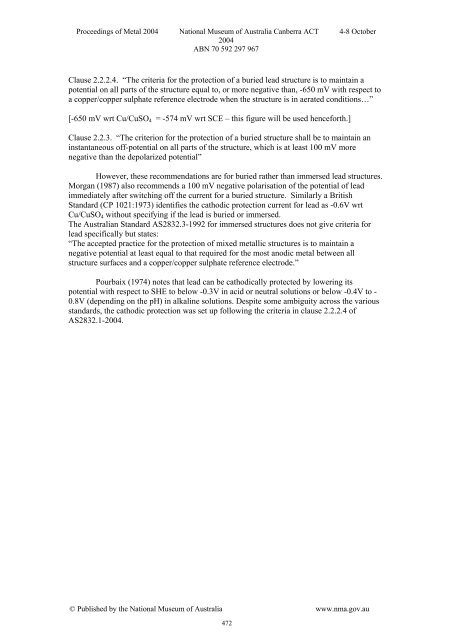Section 4: Composite artefacts (PDF 20858kb) - National Museum of ...
Section 4: Composite artefacts (PDF 20858kb) - National Museum of ...
Section 4: Composite artefacts (PDF 20858kb) - National Museum of ...
- No tags were found...
Create successful ePaper yourself
Turn your PDF publications into a flip-book with our unique Google optimized e-Paper software.
Proceedings <strong>of</strong> Metal 2004 <strong>National</strong> <strong>Museum</strong> <strong>of</strong> Australia Canberra ACT 4-8 October2004ABN 70 592 297 967Clause 2.2.2.4. “The criteria for the protection <strong>of</strong> a buried lead structure is to maintain apotential on all parts <strong>of</strong> the structure equal to, or more negative than, -650 mV with respect toa copper/copper sulphate reference electrode when the structure is in aerated conditions…”[-650 mV wrt Cu/CuSO 4 = -574 mV wrt SCE – this figure will be used henceforth.]Clause 2.2.3. “The criterion for the protection <strong>of</strong> a buried structure shall be to maintain aninstantaneous <strong>of</strong>f-potential on all parts <strong>of</strong> the structure, which is at least 100 mV morenegative than the depolarized potential”However, these recommendations are for buried rather than immersed lead structures.Morgan (1987) also recommends a 100 mV negative polarisation <strong>of</strong> the potential <strong>of</strong> leadimmediately after switching <strong>of</strong>f the current for a buried structure. Similarly a BritishStandard (CP 1021:1973) identifies the cathodic protection current for lead as -0.6V wrtCu/CuSO 4 without specifying if the lead is buried or immersed.The Australian Standard AS2832.3-1992 for immersed structures does not give criteria forlead specifically but states:“The accepted practice for the protection <strong>of</strong> mixed metallic structures is to maintain anegative potential at least equal to that required for the most anodic metal between allstructure surfaces and a copper/copper sulphate reference electrode.”Pourbaix (1974) notes that lead can be cathodically protected by lowering itspotential with respect to SHE to below -0.3V in acid or neutral solutions or below -0.4V to -0.8V (depending on the pH) in alkaline solutions. Despite some ambiguity across the variousstandards, the cathodic protection was set up following the criteria in clause 2.2.2.4 <strong>of</strong>AS2832.1-2004.© Published by the <strong>National</strong> <strong>Museum</strong> <strong>of</strong> Australia www.nma.gov.au472
















